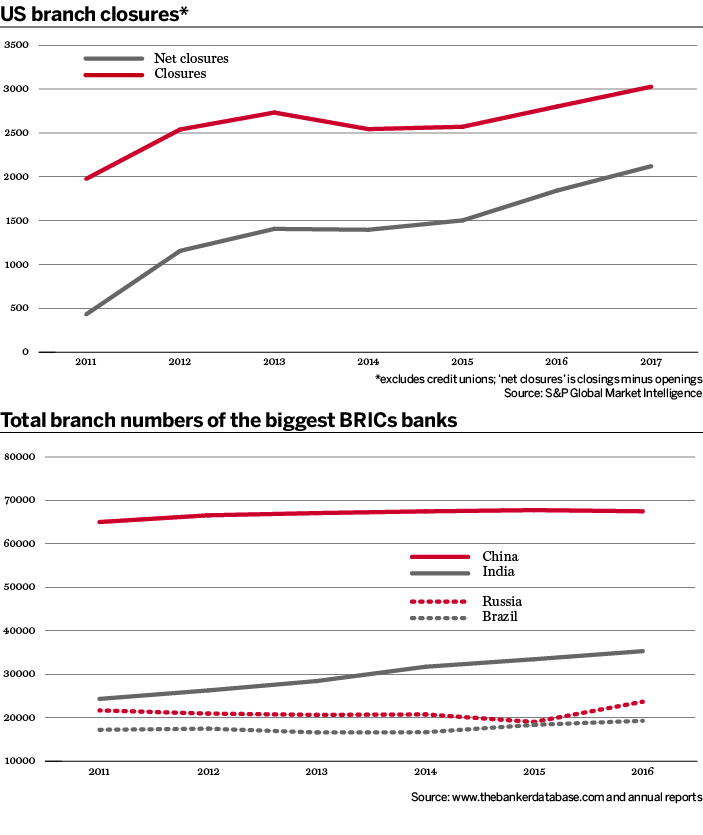While customers in the West lament the closure of their High Street branches, emerging markets continue to see new openings despite the digital revolution. Danielle Myles analyses the data.
Banks from the most advanced financial markets are shutting branches at a more rapid rate than ever before. There are two main reasons for this. First, bulge brackets have closed overseas offices to rationalise their operations and cut costs as part of their post-crisis restructuring. Second, the speedy adoption of online and mobile banking by retail customers is seen as justification for closing high street retail branches. Indeed, a report by consultancy CACI forecasts that by 2022 the average person will visit a UK branch just four times each year.
More than 16,000 branches have closed across the US over the past six years, according to S&P Global Market Intelligence. Even after taking into account new openings, Americans have nearly 10,000 fewer branches today than they did in 2011. Closures plateaued between 2012 and 2015, but have picked up again since then. Net closures have steadily increased since 2011.
The UK, a much smaller market, has seen a proportionally greater decline. Final figures for 2017 are not yet available but consumer group Which? estimates that more than 1700 branches have closed in the past three years. A recent parliamentary report found there are now 1500 communities in the country without a bank branch and 840 with just one.
Data collected by The Banker shows that these countries’ biggest banks embody this trend. In the five years to 2016, Bank of America Merrill Lynch’s global branch count (including overseas subsidiaries) shrank by 20%, which equals a net closure of 1120 offices. Meanwhile, beleaguered RBS slashed more than 2400 branches (nearly two-thirds of its network) and Barclays’ UK branch network shrank by 20%.
Emerging markets expand
Emerging market data over the same five-year period, however, does not mirror the demise of the Western bank branch. This is despite predictions that underbanked communities will leapfrog branch banking and move straight to mobile. Using the biggest four banks in the so-called BRICs (Brazil, Russia, India and China) as a yardstick, branch numbers have increased since 2011 – and it is not down to their overseas expansions.
In India, State Bank of India, ICICI, HDFC and Axis collectively saw their branch networks grow nearly 50% between 2011 and 2016. Over the same period HDFC and Axis’s Indian networks more than doubled, while ICICI’s grew by 76%.
Meanwhile Itaú Unibanco, Banco do Brasil, Bradesco and Santander’s Brazilian subsidiary expanded their physical footprint by 12%. In the two years to 2016, Itaú and Bradesco both increased their domestic networks by between 14% and 15%, adding about 1200 local branches between them.
The branch network of Russia’s big four – Sberbank, VTB, Gazprombank and Alfa – expanded nearly 10% in this time. However, the county has followed a different trajectory to India and Brazil. Numbers steadily declined from 2011 to 2015 before surging in 2016. The country’s biggest lender, Sberbank, has been closing branches to cut costs.
A more complex dynamic is playing out in China. Its biggest four banks, ICBC, China Construction Bank, Bank of China and Agricultural Bank of China, saw a modest 3.8% increase in branch numbers – reflected in both their domestic and international presence – in the five years to 2016. Their total assets, meanwhile, grew by more than 35%. This discrepancy is in line with the sweeping digitisation of Chinese retail banking (most transactions are conducted via e-payments, making cash and cards a rarity). While the country’s financial system is developing and individuals’ access to financing improving at a rapid pace, bank branches are only playing a small role in this maturation.
All data sourced from www.thebankerdatabase.com



